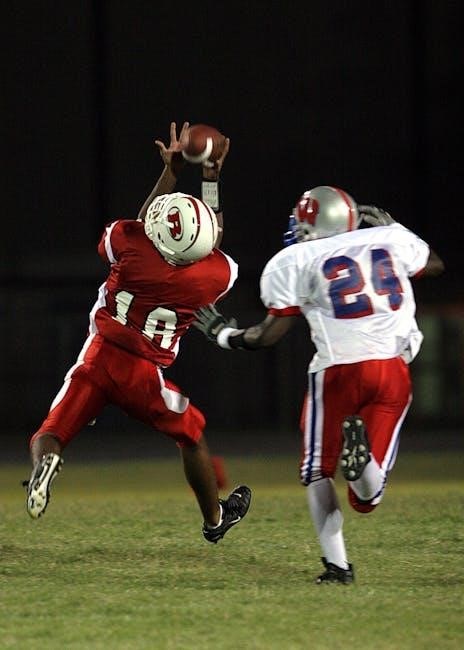An offense playbook is a foundational guide outlining strategies, plays, and adjustments for a football team. It serves as a blueprint for coaches and players to align their execution, ensuring clarity and consistency in game planning. A well-structured playbook adapts to modern trends while maintaining core principles, helping teams achieve their offensive goals effectively.

1.1 What is an Offense Playbook?
An offense playbook is a detailed guide outlining a team’s offensive strategies, plays, and formations. It includes diagrams, terminology, and adjustments to exploit defensive weaknesses. Coaches use it to standardize communication, ensuring players understand their roles. Playbooks adapt to modern trends, like the Single Wing Offense or Spread Offense, while maintaining core principles. Available as PDFs, they provide a visual breakdown of plays, such as motion sweeps or play-action passes, helping teams prepare for various game situations. A well-organized playbook is essential for consistency and success in football, serving as a blueprint for in-game execution and strategic adjustments.
1.2 Importance of a Well-Structured Playbook
A well-structured playbook is crucial for offensive success, providing clarity and consistency in strategy execution. It standardizes terminology, ensuring everyone understands their roles and responsibilities. By organizing plays into formations and situational concepts, it enhances preparation for various game scenarios. Playbooks also adapt to modern trends, such as Single Wing or Spread Offense, while incorporating proven schemes like RPOs and play-action passes. A clear playbook reduces confusion, allowing players to focus on execution. Its effectiveness is evident in teams like the Permians, who improved performance after refining their playbook. Accessible formats like PDFs make it easier for teams to study and implement strategies effectively.
1.3 Evolution of Offensive Strategies in Football
Offensive strategies in football have evolved significantly, from traditional run-heavy systems to modern, dynamic approaches. The Single Wing Offense, popular in the early 20th century, emphasized direct snaps and misdirection. Today, teams adopt Spread Offense and Air Raid systems, focusing on speed and passing efficiency. The integration of RPOs (Run-Pass Options) and motion concepts has added layers of complexity. Playbooks now incorporate situational plays, such as short-yardage and red-zone efficiency schemes. This evolution reflects the need for adaptability and innovation, as seen in teams like the Permians, who adjusted their playbook to achieve better performance. Access to resources like PDF guides has democratized these strategies, allowing teams at all levels to modernize their approaches;

Fundamentals of an Offensive Playbook
An offensive playbook outlines essential formations, alignments, and motion concepts. It serves as a guide for executing base plays, adapting to defenses, and achieving strategic goals.
2.1 Key Components of an Offense Playbook
An offensive playbook consists of foundational plays, formations, and motion concepts. It includes detailed diagrams, player assignments, and adjustments for various defensive looks. Key components also involve a consistent naming system, ensuring clarity for players and coaches. The playbook outlines base runs, passes, and play-action fakes, along with situational plays for red-zone and short-yardage scenarios. Adaptability is crucial, allowing for in-game adjustments and audibles. A well-organized playbook aligns with the team’s philosophy, ensuring efficiency and execution. It serves as a strategic guide, enabling the offense to exploit defensive weaknesses and achieve consistent success on the field.
2.2 Common Formations and Alignments
Common formations in an offense playbook include the Single Wing, Spread, and Pro Set. The Single Wing features a tight formation with wingbacks and a fullback, emphasizing power runs. The Spread Offense aligns receivers wide to create mismatches and exploit defensive gaps. Pro Set formations balance run and pass options with two backs and tight ends. Alignments like trips (three receivers) or heavy sets (multiple tight ends) are used to adapt to defensive schemes. These formations are foundational, allowing offenses to dictate matchups and control the flow of the game while maintaining flexibility for adjustments. Proper alignment is critical for execution and success.
2.3 Motion and Shift Concepts
Motion and shift concepts in an offense playbook enhance flexibility and create mismatches. Pre-snap shifts, like “motion sweep” or “shift dive,” reposition players to exploit defensive weaknesses. In-motion plays, such as the Single Wing Offense’s TB Motion Sweep, enable dynamic adjustments. Shifts can transition between formations, confusing defenses. For example, a “strong” side shift may overload one side, while “weak” shifts isolate receivers. These concepts, detailed in playbooks like the Single Wing Offense Playbook 2.0, allow offenses to dictate matchups and control defensive alignments, maximizing scoring opportunities through strategic player movement and alignment adjustments. Proper execution ensures unpredictability and offensive success.

Popular Offensive Playbook Strategies
Popular strategies include the Single Wing, Spread, Air Raid, and Wing-T offenses. Each system emphasizes unique strengths like power running, passing efficiency, or misdirection to outmatch defenses.
3.1 The Single Wing Offense
The Single Wing Offense is a classic system emphasizing power running and misdirection. Originating in the early days of football, it features a wingback aligned close to the tackle, creating an unbalanced line. This formation allows for powerful rushing attacks, with the wingback serving as a key blocker and ballcarrier. The offense relies on deception, using reverses and counters to exploit defensive weaknesses. Its compact alignment and physical style make it effective in short-yardage situations. While less common in modern football, the Single Wing remains popular in youth and high school programs due to its simplicity and ability to control the clock.
3.2 The Spread Offense
The Spread Offense is a modern, versatile system designed to exploit defensive mismatches. It features multiple wide receivers, often three or four, to create one-on-one matchups and stretch the field horizontally. By spacing players out, the offense forces defenses to cover more area, creating opportunities for big plays. The quarterback plays a central role, often using RPOs (Run-Pass Options) to decide whether to hand off or throw based on defensive alignment. The Spread Offense emphasizes speed, precision, and the ability to attack through both the run and pass game, making it a favorite in today’s fast-paced football landscape.
3.3 The Air Raid System
The Air Raid System is a pass-heavy offensive strategy emphasizing quick throws and high-percentage completions. Developed by coaches like Hal Mumme and Mike Leach, it relies on a simplified playbook with a focus on timing routes and spacing. The system often features four wide receivers, creating mismatches and forcing defenses to cover the entire field. Quarterbacks thrive in this system by making quick decisions and delivering accurate passes. The Air Raid is designed to control tempo and exploit defensive weaknesses through precision and repetition, making it a powerful tool for teams looking to dominate through the air.
3.4 The Wing-T Offense
The Wing-T Offense is a run-heavy, misdirection-based system that emphasizes physicality and control. Originating from the T-formation, it incorporates wingbacks and tight ends to create multiple blocking angles. The offense relies on counters, traps, and sweeps to attack defensive gaps. The triple-option concept challenges defenses with a fullback, wingback, and quarterback as threats. This system thrives on execution, timing, and deception, making it difficult for defenses to anticipate plays. It’s ideal for teams with strong offensive lines and backs, allowing them to dominate time of possession and wear down opponents physically.

Creating Your Offensive Playbook
Develop a clear offensive philosophy, define team identity, and include key components like formations, plays, and adjustments. Tailor strategies to team strengths and game situations. Keep it simple for execution, ensuring organization and clarity. Regularly review and update plays to maintain effectiveness and adapt to opponents. This structured approach ensures consistency and success on the field.
4.1 Developing Your Offensive Philosophy
Developing your offensive philosophy involves defining your team’s identity and core beliefs. It should align with your personnel’s strengths, the coach’s vision, and the desired style of play. Consider factors like tempo, downfield threats, and run-pass balance. A clear philosophy guides play design, player development, and in-game decisions. It should be adaptable to various game situations while remaining true to your team’s DNA. Simplicity and clarity are key to ensure players understand and execute the system effectively. Regularly review and refine your philosophy to ensure it remains relevant and effective against evolving defenses.
4.2 Designing Plays for Different Situations
Designing plays for different situations is crucial for a dynamic offense. Begin by identifying key game scenarios: red zone, third and long, goal line, two-minute drill, short yardage, and end of game. Analyze defensive tendencies in these moments to exploit weaknesses. Leverage your team’s strengths, whether a powerful run game or a speedy receiver. Create play variations adaptable to defensive alignments, such as runs that convert to passes. Ensure players practice these plays extensively for confident execution. Post-game, review performance and refine strategies to maintain effectiveness. This approach ensures your playbook is tailored to conquer any situation, maximizing your team’s chances of success.
4.3 Implementing a Consistent Naming System
A consistent naming system is essential for clarity and efficiency in your playbook. Use a standardized format for play names, such as formation + action + strength + depth. For example, “Strong I 32 Dive” clearly communicates the formation, play type, and blocking scheme. Assign distinct codes for motion, shifts, and audibles to avoid confusion. Ensure terminology aligns with your team’s vocabulary and is easily memorable. This system streamlines communication and execution, enabling players to quickly understand assignments. Regularly review and refine the naming system to maintain simplicity and effectiveness as your playbook evolves.
4.4 Organizing Plays Efficiently
Organizing plays efficiently in your playbook ensures quick access and clarity. Categorize plays by type (run, pass, screen), formation, and personnel group. Use clear headings and subheadings to separate sections. Include visual diagrams and play scripts side-by-side for easy understanding. Group situational plays (e.g., red-zone, third-and-short) together for game-plan efficiency. Use tabs or indexes to navigate seamlessly. Assign each play a unique identifier for reference during practice and games. Regularly update and streamline the playbook to reflect your team’s strengths and opponents’ weaknesses; This structure enhances preparation, execution, and adaptability, making your playbook a valuable game-day resource.

Key Plays in an Offense Playbook
Every playbook relies on foundational plays that balance running and passing, creating versatility and exploiting defensive weaknesses. These plays form the backbone of offensive success and adaptability.
5.1 Power Running Plays
Power running plays are designed to gain tough yards, often in short-yardage situations. These plays rely on physicality and execution, with tight formations and a focus on blocking. Fullbacks and tight ends play key roles in clearing pathways, while offensive linemen execute precise blocks to create seams. The running back must identify and hit the hole quickly, using vision and strength to break tackles. Power runs are essential for maintaining possession, converting third-and-short situations, and controlling the clock. They are foundational to any offense, ensuring the ability to run effectively in critical moments. Proper execution makes these plays unstoppable in key situations.
5.2 Play-Action Passes
Play-action passes are a high-impact strategy that exploits defensive aggression. By mimicking a handoff to a running back, the quarterback deceives defenders into committing to the run, creating open receivers downfield. These plays are particularly effective in early downs or short-yardage situations, where defenses anticipate a run. The key to success lies in the fake handoff and the offensive line’s ability to sell the run. Play-action passes often target deep zones, leading to big plays. Proper execution, including the quarterback’s ability to maintain the illusion, is crucial for maximizing their effectiveness and keeping defenses guessing. They are a cornerstone of balanced offenses, enhancing overall versatility.
5.3 Screen Plays
Screen plays are short, high-percentage passes designed to quickly get the ball to playmakers in space. They often target receivers or running backs, utilizing blockers to create lanes. These plays counter aggressive defenses by luring them into pursuing the ball carrier. Timing and blocking are critical, as the quarterback must deliver the ball precisely while linemen and receivers block defenders. Screens are effective in third-down situations or to spark stalled drives. Variations include wide receiver screens, running back screens, and tight end screens. When executed well, screens can turn into significant gains, making them a reliable and dynamic part of any offense playbook.
5.4 Deep Passing Concepts
Deep passing concepts are designed to attack defenses vertically, stretching the field and creating explosive plays. These plays often involve routes like go, post, and fade patterns, targeting receivers who can separate downfield. Timing and accuracy are critical, as quarterbacks must deliver the ball to receivers in stride. Deep passes are typically used to exploit single coverage or safeties who bite on play-action. They are also effective for loosening defenses and opening up underneath throws. Play-action deep passes and bootleg deep throws are common variations. While high-risk, a well-executed deep pass can result in a touchdown or significant yardage, making it a vital part of any offense playbook.

Advanced Concepts in Offensive Playbooks
Advanced concepts in offensive playbooks focus on dynamic adjustments, pre-snap reads, and high-level execution strategies to exploit defensive weaknesses. These tactics enhance play design and player execution.
6.1 RPOs (Run-Pass Options)
RPOs, or Run-Pass Options, are advanced offensive strategies combining running and passing plays seamlessly. They exploit defensive alignments by reading key defenders post-snap. Coaches design RPOs to attack specific coverages or box counts. The quarterback’s ability to make quick decisions is crucial. RPOs often feature quick passes or zone runs, creating mismatches and maximizing efficiency. Proper execution requires precise timing and alignment to avoid defensive reactions. RPOs are versatile, fitting various formations and situations, making them a cornerstone of modern offenses seeking to dominate possessions and control tempo. They blend simplicity with strategic complexity, enhancing overall offensive effectiveness.
6.2 Bootleg and Play-Action Variations
Bootleg and play-action variations are deceptive offensive tactics designed to exploit defensive aggression. A bootleg involves the quarterback faking a handoff and rolling out in the opposite direction, creating throwing opportunities. Play-action passes mimic running plays to freeze defenders, allowing receivers to gain separation. These concepts rely on selling the fake and timing to manipulate defensive reactions. They are effective in neutralizing pass rushes and creating open throwing lanes. Variations include bootleg passes, naked bootlegs, and play-action deep shots. Proper execution and alignment are critical to maximizing their effectiveness in high-leverage situations like third downs or red-zone opportunities. These plays enhance offensive unpredictability and control defensive aggression.
6.3 Utilizing Motion to Create Mismatches
Motion is a dynamic tool in offensive playbooks to create mismatches and exploit defensive vulnerabilities. By moving players pre-snap, offenses force defenses to adjust, often leading to favorable one-on-one matchups. Horizontal motion can create width, isolating receivers, while vertical motion can uncover coverage weaknesses. Orbital motion, involving players rotating into new positions, adds unpredictability. Motion also reveals defensive tendencies, allowing quarterbacks to make informed decisions. Effective motion design requires precise timing and execution to avoid penalties. Coordinators often combine motion with RPOs or play-action to amplify its impact, keeping defenses guessing and enhancing offensive efficiency in critical situations.
6.4 Red Zone Efficiency Plays
Red zone efficiency plays are critical for converting scoring opportunities into points. These plays focus on high-percentage throws and physical runs to overcome tight defensive alignment. Goal-line fades, tight end corner routes, and short crossing patterns are common. Power runs and dive plays attack defensive weaknesses. Pre-snap motion and RPOs create mismatches. Situational awareness is key, as quarterbacks must quickly identify coverage. These plays are practiced extensively to ensure execution under pressure. A well-designed red zone package maximizes scoring potential, often deciding game outcomes. Coaches emphasize precision and physicality in these high-leverage situations to capitalize on offensive opportunities.

Adjusting the Playbook for Different Opponents
Each opponent is unique, requiring customization. Identify strengths and weaknesses, tailor plays to exploit defensive vulnerabilities, and emphasize offensive strengths. Adaptability and flexibility are key.
7.1 Analyzing Defensive Strengths and Weaknesses
Analyzing defensive strengths and weaknesses is critical for offensive success. Begin by studying opponents’ schemes, player tendencies, and performance data. Identify vulnerabilities in pass coverage, run defense, and blitz packages. Focus on defensive alignments, gaps, and reaction times. Use game footage to assess strengths, such as pass rush or secondary depth. Statistical analysis reveals trends in defensive efficiency. Tailor your playbook to exploit weaknesses while neutralizing their strengths. This process ensures your offense is prepared to attack effectively and adapt during the game. Detailed analysis is the foundation for strategic adjustments and in-game execution.
7.2 Game-Planning Specific Plays
Game-planning specific plays involves tailoring your offense to exploit the opponent’s defensive weaknesses. Start by identifying key vulnerabilities through film study and data analysis. Design plays that target these gaps, ensuring they align with your team’s strengths. Balance the playbook to maintain flexibility while focusing on high-impact strategies. Organize plays into situational categories, such as red-zone or third-down scenarios. Prioritize simplicity and execution, allowing players to master the selected plays. This targeted approach enhances offensive efficiency and increases the likelihood of success during the game.
7.3 In-Game Adjustments and Audibles
In-game adjustments and audibles are critical for countering defensive strategies. Coaches and quarterbacks must quickly identify defensive alignments and exploit weaknesses. Audibles allow the offense to change plays at the line of scrimmage based on defensive looks. This requires precise communication and pre-practice adjustments. Players must be trained to recognize patterns and react swiftly. Effective in-game adjustments often involve simplifying plays or emphasizing strengths. By staying flexible and proactive, offenses can maintain control and capitalize on opportunities, ensuring adaptability and success during the game.
Case Studies of Successful Playbooks
Examining elite teams’ playbooks reveals strategic brilliance. The Kansas City Chiefs, New England Patriots, and innovative college programs showcase adaptability, alignment with personnel, and game-changing concepts.
8.1 The Kansas City Chiefs’ Offense
The Kansas City Chiefs’ offense, under Andy Reid and Patrick Mahomes, is a dynamic, explosive system. Their playbook emphasizes speed, versatility, and exploiting defensive weaknesses. Utilizing a mix of RPOs, play-action passes, and deep shots, they create mismatches and stretch defenses. The Chiefs’ ability to adapt in-game and execute high-percentage throws is unparalleled. Their red-zone efficiency and use of motion highlight their offensive brilliance. This playbook exemplifies modern football innovation, blending creativity with precision, making it a blueprint for success in the NFL.
8.2 The New England Patriots’ Playbook
The New England Patriots’ playbook, under Bill Belichick, is renowned for its adaptability and precision. It emphasizes disciplined execution, situational football, and exploiting defensive weaknesses. Their offense often features a mix of play-action passes, quick slants, and high-percentage throws. The Patriots excel at identifying mismatches and leveraging their tight ends and running backs in the passing game. Their ability to adjust in-game and execute in critical situations is a hallmark of their success. This systematic approach, combined with Tom Brady’s legendary execution, has made their playbook a model of consistency and effectiveness in the NFL.
8.3 College Football’s Most Innovative Playbooks
College football is a hotbed of offensive innovation, with playbooks constantly evolving to exploit defensive vulnerabilities. Programs like Baylor and Georgia Tech have popularized the Air Raid and triple option systems, respectively. These strategies, emphasizing speed and misdirection, challenge defenses and inspire NFL tactics. Coaches such as Mike Leach and Paul Johnson have pioneered these approaches, creating complex plays that adapt to various situations. The integration of technology and analytics further refines playbook designs, enhancing their effectiveness. This dynamic innovation often influences professional leagues, demonstrating college football’s role as a nursery for offensive creativity.

Tools and Resources for Building a Playbook
Software like Hudl and Playbook help coaches design plays, while online tutorials and forums provide guidance. Communities share strategies, enhancing playbook creation efficiency and innovation.
9.1 Software for Creating Playbooks
Software like Hudl, Playbook, and Football Play Card are essential tools for designing offensive playbooks. These platforms offer features like play diagramming, animation, and libraries for organizing schemes. Coaches can easily create and share playbooks, export them as PDFs, and collaborate with staff. Advanced tools provide analytics and video integration, enhancing strategy development. These programs streamline the process, saving time and ensuring clarity. By leveraging technology, coaches can focus on innovation and execution, making their playbooks more dynamic and effective for game-day success.
9.2 Online Tutorials and Guides
Online tutorials and guides provide valuable resources for creating and refining an offense playbook. Websites like YouTube and Coach’s Clinic offer step-by-step videos and downloadable templates. These guides often include detailed breakdowns of formations, plays, and strategies, making it easier for coaches to implement them. Many resources are available in PDF format, allowing for easy printing and sharing. Additionally, forums and communities share insights, helping coaches adapt plays to their team’s strengths. These tools are indispensable for both novice and experienced coaches aiming to enhance their playbook’s effectiveness and stay updated on modern strategies.
9.3 Community Sharing and Collaboration
Community sharing and collaboration are vital for refining and expanding an offense playbook. Coaches often share playbook ideas and strategies through forums, social media groups, and specialized websites. Platforms like Reddit’s r/footballcoaching and Coaches’ Corner allow for the exchange of PDF playbooks, enabling teams to adopt and adapt successful plays. Collaboration fosters innovation, as coaches learn from each other’s strengths and weaknesses. Sharing resources ensures that teams stay updated with modern strategies, while feedback from peers helps refine playbook designs. This collective approach enhances overall offensive efficiency and promotes continuous improvement in the game.

Best Practices for Coaches and Players
Coaches should regularly update playbooks and ensure clarity for players. Emphasize understanding over complexity, use digital tools for accessibility, and foster open communication for continuous improvement.
10.1 Simplifying Complexity for Players
Simplifying complexity for players is crucial for effective execution. Coaches should break down plays into basic components, using visual aids like diagrams and videos. Consistent terminology helps avoid confusion, while focusing on key assignments ensures clarity. Prioritize core concepts over excessive play volume, allowing players to master fundamentals before advancing. Encourage hands-on learning through drills and repetition, enabling players to grasp concepts physically. Create a progression from simple to complex plays, building confidence and competence. Involve players in the process, fostering ownership and understanding. Simplification enhances retention, execution, and overall team performance.
10.2 Practicing and Mastering Key Plays
Mastering key plays requires deliberate practice and repetition. Coaches should design drills that isolate specific skills, such as footwork or route running, to build muscle memory. Film study is essential for players to visualize and correct execution. Repetition during practice ensures familiarity and confidence. Gradually increase complexity by introducing variations of core plays. Provide immediate feedback to address errors and reinforce proper technique. Encourage players to focus on execution over speed, emphasizing precision in alignments and assignments. Consistent practice routines help players internalize the playbook, allowing them to perform instinctively during games. Mastery breeds confidence and enhances overall offensive efficiency.
10.3 Reviewing and Updating the Playbook
Regularly reviewing and updating the playbook ensures it remains effective and relevant. Coaches should analyze game footage to identify strengths and weaknesses, making adjustments based on performance. Incorporate player feedback to refine plays and improve execution. Update the playbook seasonally or weekly, adapting to opponents’ strategies and team progress. Maintain a balanced mix of core plays and innovative concepts to keep defenses guessing. Organize updates clearly, ensuring players understand changes quickly. A dynamic playbook reflects team growth and strategic evolution, fostering long-term success and adaptability in competitive environments. Consistent reviews ensure the playbook aligns with team goals and player capabilities.
